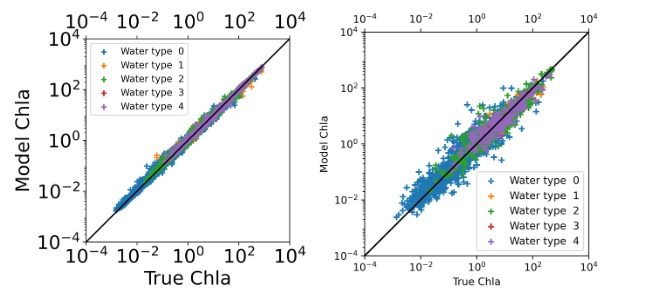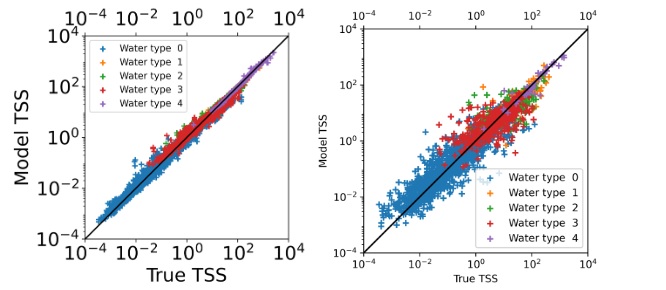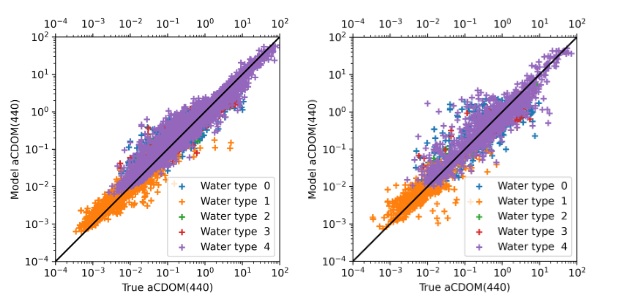Performance Assessment of Models for Sentinel-2
Performance Assessment of the Chlorophyll-a estimation model
Chlorophyll-a (Chl-a) (measured in mg m-3) is a crucial indicator of water quality, particularly in assessing the presence and abundance of algae and phytoplankton. Monitoring Chl-a helps in understanding the primary productivity of aquatic ecosystems and the potential for eutrophication.Reflectance ratios at specific wavelengths are widely used as reliable proxies for estimating Chl-a concentrations, owing to the distinct optical absorption and scattering properties of phytoplankton pigments. In optically clear waters, where interference from suspended particles and colored dissolved organic matter (CDOM) is minimal, the ratio of reflectance in the blue to green spectral regions effectively captures the strong absorption of Chl-a in the blue and minimal absorption in the green, making it a sensitive indicator of Chl-a levels. However, in turbid or highly productive waters, where the optical signal is influenced by higher concentrations of suspended solids and phytoplankton, the blue region is often compromised. In such cases, reflectance ratios involving the red and near-infrared bands are more effective, as Chl-a shows a characteristic absorption in the red (around 665 nm) and enhanced backscattering in the NIR, enabling more accurate quantification of Chl-a under complex water conditions.The present chlorophyll-a (Chl-a) estimation model, derived using machine learning (ML) techniques, was developed from approximately 14,100 paired observations of in-situ Chl-a concentrations and coincident remote sensing reflectance (Rrs) measurements, spanning five distinct optical water types across global inland and coastal waterbodies (Fig. 1). For model training and evaluation, 80% of the dataset was allocated to training (hereafter referred to as the train dataset), while the remaining 20% was withheld for independent validation (hereafter referred to as the test dataset). Fig. 1. Median of Normalised Rrs spectra, classified into five different water types with the k-means clustering technique, used for training the Chl-a estimation model.Figure 2 presents scatter plots illustrating the model-derived Chl-a estimates for both the training and test datasets. Table 1 provides a summary of the model evaluation using seven error metrics: Bias, Intercept, Median Absolute Percentage Difference (MAPD), Normalised Root Mean Squared Error (NRMSE), Normalised Mean Absolute Error (NMAE), coefficient of determination (R²), and slope of the regression line.
Fig. 1. Median of Normalised Rrs spectra, classified into five different water types with the k-means clustering technique, used for training the Chl-a estimation model.Figure 2 presents scatter plots illustrating the model-derived Chl-a estimates for both the training and test datasets. Table 1 provides a summary of the model evaluation using seven error metrics: Bias, Intercept, Median Absolute Percentage Difference (MAPD), Normalised Root Mean Squared Error (NRMSE), Normalised Mean Absolute Error (NMAE), coefficient of determination (R²), and slope of the regression line. Fig. 2. Scatter plot of model-derived Chl-a versus true Chl-a for train datasets (80%) [Left] and test datasets (20%) [Right].
Fig. 2. Scatter plot of model-derived Chl-a versus true Chl-a for train datasets (80%) [Left] and test datasets (20%) [Right].
| Metric | Train (80%) | Test (20%) | Desired |
|---|---|---|---|
| Bias | 0.649 | 1.734 | 0.0 |
| Intercept | 0.453 | 0.495 | 0.0 |
| MAPD (%) | 7.021 | 30.285 | < = 30.0 |
| NMAE | 0.001 | 0.008 | 0.0 |
| NRMSE | 0.007 | 0.026 | 0.0 |
| R² | 0.979 | 0.868 | > = 0.8 |
| Slope | 0.916 | 0.818 | 1.0 |
Performance assessment of the Total Suspended Solids estimation model
Total Suspended Solids (TSS) (measured in g m-3) is a key indicator of water quality, particularly in assessing the presence and abundance of suspended particles, primarily inorganic salts and sediments. Monitoring TSS helps in understanding the pollution level due to wastewater discharge or sediment transport.Reflectance ratios at specific wavelengths are strongly correlated with turbidity, quantified as TSS concentration. In optically clear waters, the ratio of reflectance in the blue and green spectral regions is particularly sensitive to low concentrations of suspended particles. This sensitivity arises because suspended solids preferentially scatter and absorb light in the shorter wavelengths, causing measurable changes in the blue-to-green reflectance ratio. As TSS concentration increases, especially in more turbid waters, the spectral response tends to shift toward longer wavelengths, necessitating the use of red or near-infrared bands for more accurate quantification.The present TSS estimation model, derived using machine learning (ML) techniques, was developed from approximately 14,600 paired observations of in-situ TSS concentrations and coincident remote sensing reflectance (Rrs) measurements, spanning five distinct optical water types across global inland and coastal waterbodies (Fig. 3). For model training and evaluation, 80% of the dataset was allocated to training (hereafter referred to as the train dataset), while the remaining 20% was withheld for independent validation (hereafter referred to as the test dataset). Fig. 3. Median of Normalised Rrs spectra, classified into five different water types with the k-means clustering technique, used for training the TSS estimation model.Figure 4 presents scatter plots illustrating the model-derived TSS estimates for both the training and test datasets. Table 2 provides a summary of the model evaluation using seven error metrics: Bias, Intercept, Median Absolute Percentage Difference (MAPD), Normalised Root Mean Squared Error (NRMSE), Normalised Mean Absolute Error (NMAE), coefficient of determination (R²), and slope of the regression line.
Fig. 3. Median of Normalised Rrs spectra, classified into five different water types with the k-means clustering technique, used for training the TSS estimation model.Figure 4 presents scatter plots illustrating the model-derived TSS estimates for both the training and test datasets. Table 2 provides a summary of the model evaluation using seven error metrics: Bias, Intercept, Median Absolute Percentage Difference (MAPD), Normalised Root Mean Squared Error (NRMSE), Normalised Mean Absolute Error (NMAE), coefficient of determination (R²), and slope of the regression line. Fig. 4. Scatter plot of model-derived TSS versus true TSS for train datasets (80%) [Left] and test datasets (20%) [Right].
Fig. 4. Scatter plot of model-derived TSS versus true TSS for train datasets (80%) [Left] and test datasets (20%) [Right].
| Metric | Train (80%) | Test (20%) | Desired |
|---|---|---|---|
| Bias | 1.002 | 3.005 | 0.0 |
| Intercept | 0.768 | 0.561 | 0.0 |
| MAPD (%) | 6.763 | 30.045 | < = 30.0 |
| NMAE | 0.001 | 0.004 | 0.0 |
| NRMSE | 0.005 | 0.015 | 0.0 |
| R² | 0.964 | 0.875 | > = 0.8 |
| Slope | 0.881 | 0.769 | 1.0 |
Performance assessment of the aCDOM(440) estimation model
Absorption coefficient of Colored Dissolved Organic Matter (aCDOM) at 440 nm (measured in m-1) is a key indicator of water quality, particularly in assessing the presence and abundance of decaying organic substances. It provides insights into the concentration of coloured dissolved organic matter, which influences water clarity, ecological health, and biogeochemical cycles.Spectral reflectance ratios at specific wavelengths strongly correlate with the aCDOM(440). aCDOM(440) primarily influences light absorption in the ultraviolet and blue regions of the spectrum due to the presence of humic and fulvic substances derived from terrestrial and aquatic sources. In particular, the ratio of reflectance in the blue to green regions is sensitive to variations in aCDOM(440), as CDOM strongly absorbs shorter wavelengths while exerting minimal influence on the green region. As aCDOM(440) concentration increases, the absorption in the blue intensifies, leading to a decrease in reflectance in that region and thus altering the blue-to-green ratio. This spectral behaviour enables using blue-green reflectance ratios as effective indicators for estimating aCDOM(440) across diverse aquatic environments.The present aCDOM(440) estimation model, derived using machine learning (ML) techniques, was developed from approximately 12,100 paired observations of in-situ aCDOM(440) concentrations and coincident remote sensing reflectance (Rrs) measurements, spanning five distinct optical water types across global inland and coastal waterbodies (Fig. 5). For model training and evaluation, 80% of the dataset was allocated to training (hereafter referred to as the train dataset), while the remaining 20% was withheld for independent validation (hereafter referred to as the test dataset). Fig. 5. Median of Normalised Rrs spectra, classified into five different water types with the k-means clustering technique, used for training the aCDOM(440) estimation model.Figure 6 presents scatter plots illustrating the model-derived aCDOM(440) estimates for both the training and test datasets. Table 3 provides a summary of the model evaluation using seven error metrics: Bias, Intercept, Median Absolute Percentage Difference (MAPD), Normalised Root Mean Squared Error (NRMSE), Normalised Mean Absolute Error (NMAE), coefficient of determination (R²), and slope of the regression line.
Fig. 5. Median of Normalised Rrs spectra, classified into five different water types with the k-means clustering technique, used for training the aCDOM(440) estimation model.Figure 6 presents scatter plots illustrating the model-derived aCDOM(440) estimates for both the training and test datasets. Table 3 provides a summary of the model evaluation using seven error metrics: Bias, Intercept, Median Absolute Percentage Difference (MAPD), Normalised Root Mean Squared Error (NRMSE), Normalised Mean Absolute Error (NMAE), coefficient of determination (R²), and slope of the regression line. Fig. 6. Scatter plot of model-derived aCDOM(440) versus true aCDOM(440) for train datasets (80%) [Left] and test datasets (20%) [Right].
Fig. 6. Scatter plot of model-derived aCDOM(440) versus true aCDOM(440) for train datasets (80%) [Left] and test datasets (20%) [Right].
| Metric | Train (80%) | Test (20%) | Desired |
|---|---|---|---|
| Bias | 0.191 | 0.163 | 0.0 |
| Intercept | 0.092 | 0.019 | 0.0 |
| MAPD (%) | 20.022 | 34.192 | < = 30.0 |
| NMAE | 0.003 | 0.007 | 0.0 |
| NRMSE | 0.014 | 0.024 | 0.0 |
| R² | 0.882 | 0.820 | > = 0.8 |
| Slope | 0.757 | 0.849 | 1.0 |

